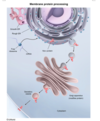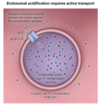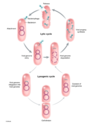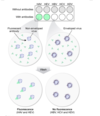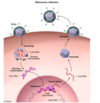BIOLOGY: Reproduction, development, viruses & prokaryotes/eukaryotes Flashcards
card 128: starts reproduction & cells
microtubule transport
The intracellular scaffolding of a eukaryotic cell is composed of three families of protein filaments:
which motor protein mediates anterograde transport?
Which mediates retrograde transport?
- Microfilaments, intermediate filaments, and microtubules.
-
Intracellular transport of cargo (eg, organelles, vesicles) is mediated primarily by two microtubular motor proteins (kinesin and dynein).
- Kinesin mediates anterograde transport (ie, away from the nucleus)
- dynein mediates retrograde transport (ie, toward the nucleus).

3 families of protein fibers

Structure of mature sperm
head contains:
midpeice contains:
tail is used for?
- head (contains the acrosome and nucleus)
- midpiece (contains mitochondria that generate the ATP required for flagellum-driven sperm motility)
- tail (ie, the flagellum necessary for motility through a fluid environment).

Fertilization image
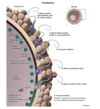
Spermatogenesis image
- spermatogonium—>spermatocyte—>spermatid–>spermatozoon

Blastulation

OOGENESIS process in a pic

Overview of mitosis
- Prophase: DNA condenses to form chromatids. Each pair of sister (identical) chromatids are joined by a region called the centromere to form chromosomes. The nuclear envelope breaks down and centrosomes (microtubule-organizing structures) migrate to opposite poles within the cell. The mitotic spindle is formed as microtubules grow from these centrosomes.
- Metaphase: Chromosomes attach to spindle fiber microtubules at their kinetochores and align at the metaphase plate, a central plane within the cell.
- Anaphase: Sister chromatids are pulled apart by the spindle fibers and move toward opposite poles of the cell. This forms two sets of chromosomes within the cell (one set at each cellular pole).
- Telophase: The nuclear envelope is reformed around each set of chromosomes. Chromosomes decondense and the parental cell undergoes cytokinesis (cytoplasmic division) to produce two identical daughter cells.

A single diploid cell containing 46 chromosomes underwent meiosis and produced four daughter cells, two with 22 chromosomes and two with 24 chromosomes. An error in which of the following stages of meiosis would most likely explain this result?
Chromosomal Disjunction
- Answer: Anaphase
- If a diploid cell with 46 chromosomes undergoes meiosis, four haploid daughter cells should be produced with each containing 23 chromosomes.
- However, in the given scenario two daughter cells have an extra chromosome and two daughter cells are missing a chromosome. Such a finding is most likely due to chromosomal nondisjunction, which occurs when either homologous chromosomes (during anaphase of meiosis I) or sister chromatids (during anaphase of meiosis II) fail to separate to opposite poles of the cell.
- Chromosomal nondisjunction during anaphase I may produce one daughter cell with an extra homologous chromosome (24 chromosomes) and one daughter cell missing a chromosome (22 chromosomes)
- Division of these cells in meiosis II would yield two cells with 22 chromosomes and two cells with 24 chromosomes.
Difference of meiosis I & meiosis II:

Metaphase chromosome

CELL CYCLE
INTERPHASE

SPERMATOGENESIS & OOGENESIS
similarities & differences

Cell Migration in embryogenesis
neural crest give rise to:
nerual tube gives rise to:
- is the movement of cells into their final positions within the embryo
- The migratory actions of neural crest cells during neurlation (the formation of the nervous system) gives rise to many peripheral nervous system structures
- schwann cells & satellite cells
-
incontrast, the central nervous system is derived from the nerual tube
- oligodendrocytes & astrocytes

3 Germ layers form during gastrulation
- Endoderm (innermost layer): gives rise to accessory digestive organs (eg, liver, pancreas) as well as to the lining (epithelium) of the digestive and respiratory tracts.
-
Mesoderm (middle layer): gives rise to the circulatory system, the musculoskeletal system, and parts of the urinary and reproductive systems.
- notochord is a mesodermal structre
- Ectoderm (outermost layer): gives rise to the nervous system (neurulation) and develops into the integumentary system, which includes hair, skin, nails, and the lining of the mouth, nostrils, and anus.

Potency during development
Totipotent
Pluripotent
Multipotent
- Totipotent stem cells are the least specialized cells and can give rise to both placental and fetal cells.
- Pluripotent stem cells can give rise to only fetal cells (ie, all cell lineages from the three germ layers).
- Multipotent cells are able to differentiate only into the specialized cells of certain tissues and are also found in adults.
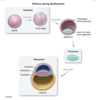
Cell determination:
Cell Differentiation
Inductive Signaling
- Cell determination (specification of cell fate)
- Cell differentiation (acquisition of unique/specialized biomedical & structural cellular characterisitcs)
- BOTH ^^ result from asymmetric segregation of cytoplasmic determinants & inductive signaling
- Cell fate is influenced by _inductive signaling_ between cells in the early embryo. In inductive signaling, an inducer (the signaling cell) releases chemical signals that act on competent neighboring cells by regulating the expression of specific genes required for cell determination.

Morphogens
-
are signaling molecules that influence cell differentiation in the emebryo
- they are released by signaling cells & diffuse outward to alter gene expression in competent cells in a conentration-dependent manner
- morphogens are paracrine factors
Apoptosis:
newborn with myelomeningocele
- newborn with myelomeningocele has HIGH incidence of apoptosis induced by oxidative stress during gestation as well as:
- Higher frequency of cell damage at critical developmental periods during gestation
- Higher cellular concentrations of free radicals during gestation
- Lower levels of enzymes with antioxidant capabilities during gestation
-
Apoptosis (programmed cell death) is crucial for normal embryonic patterning and development. Oxidative stress occurs when the body is unable to detoxify naturally generated reactive oxygen species, which then cause considerable cell damage upon accumulation.
- This damage can result in abnormal apoptosis and congenital malformations.
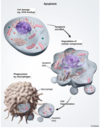
Oxidative Stress
- Oxidative stress occurs when the body is unable to detoxify reactive oxygen species (ROS), such as peroxides and free radicals.
- ROS are naturally generated from cellular reactions involving oxygenase or oxidase enzymes, as well as from reactions that take place in mitochondria (via oxidative phosphorylation) and peroxisomes (via β-oxidation of long-chain fatty acids).
- ROS contain an unstable number of electrons and are usually trapped or converted to less reactive molecules by antioxidants or enzymes with antioxidant activity, respectively.
- When ROS production exceeds the body’s natural elimination capabilities, ROS react with and damage cellular components. This type of injury can result in abnormally activated _apoptosis_.
DNA sequencing
Southern Blot
Northern Blot
- DNA sequencing and Southern blotting are DNA assays that may be used to assess the relative quantity of genes between tissue types.
- Northern blotting is an RNA assay used to assess gene expression in different tissues

Effects of estrogen & progesterone
-
in addition to image
- Bone is continuously being resorbed (broken down) by osteoclasts and rebuilt by osteoblasts. Female sex hormones maintain bone mass by helping balance the rate of osteoclast activity with the rate of osteoblast activity. Withdrawal of female sex hormones (due to ovary removal) leads to greater osteoclast than osteoblast activity, diminishing bone mass and leading to porous and fragile bone.

Vasoconstriction & vasodilation
- Vasodilation (blood vessel widening) decreases blood pressure and increases blood flow to the tissues supplied by that blood vessel.
- Vasoconstriction (blood vessel narrowing) increases blood pressure and decreases blood flow to the tissues supplied by that blood vessel.

Vasodilation & vasoconstriction with body temperature
- When body temperature is higher than normal (eg, in warm environments), blood vessels supplying the skin vasodilate to facilitate blood flow to the body surface, promoting heat loss through the skin and decreasing body temperature.
- In addition, Vasodilation of renal blood vessels inc blood flow to the kideny & consequently inc GFR (amountof blood filtered per unit time). This increased urine output & dec blood volume, worsening hydration
- When body temperature is lower than normal (eg, in cold environments), blood vessels supplying the skin vasoconstrict to limit the amount of blood reaching the body surface, limiting heat loss to the environment and increasing body temperature.
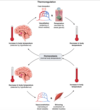
Cell cycle, checkpoints, & effectiveacncer drug target which phase?

- Most cells in the human body are arrested in G0.
- However, cellular transition into G1 prepares a cell for division and DNA synthesis (S phase). In the G2 phase, DNA is checked for errors and the cell ensures that sufficient organelles and cytoplasm are available for cell division.
- Subsequently, the cell divides in the M phase via mitosis and cytokinesis.
- Compounds that inhibit cell division typically target the cell cycle in phases G1 to M.
Control of cellular division occurs at checkpoints within the cell cycle.
- At the G1/S phase transition, the cell commits to undergoing a division cycle whereas the G2/M phase transition acts as a quality-control step in which the cell cycle is stopped and cellular components are checked for abnormalities.
- Checkpoints are regulated primarily by cyclins and cyclin-dependent kinases. Cells with abnormalities that cannot be repaired undergo apoptosis; those that pass the checkpoints continue to divide. Anticancer drugs often target these checkpoints due to the regulatory roles on the cell cycle.

Human spern & oocyte are different & same in when?
- SAME: EQUAL CONTRIBUTION OF CHROMOSOMES TO A ZYGOTE
-
DIFFERENT:
- cell volume: sperm is the smallest cell in the human body (neglgible cytoplasm), egg is the largest human cell & has organelles and large amount of cytoplasm
-
matrutation at birth
- testes contain immature germ cells (spermatogonia), they begin to undergo meiosis at puberty (early teen years) when the gonads mature
- girls have primary oocyte arrested at prophse of meiosis I & remain in this state until ovulatory cycle beings at puberty
- rate at whch they are produced
Oogenesis
- Oogenesis is the process by which females produce sex cells (gametes) called eggs. All of a woman’s developing eggs (oocytes) are produced during fetal development.
- At birth, their maturation is arrested in prophase I; these arrested eggs are known as primary oocytes. At puberty, the menstrual cycle begins, and each month a single primary oocyte develops into a secondary oocyte by continuing meiosis up to metaphase II.
Fertilization & implantation








